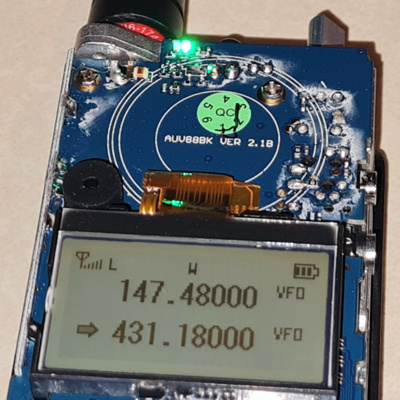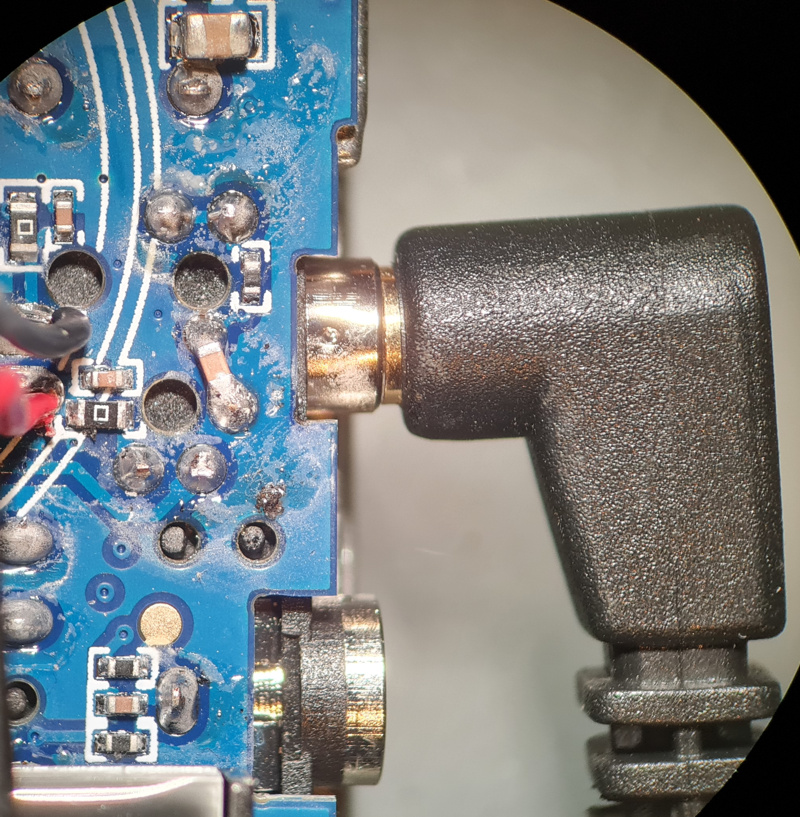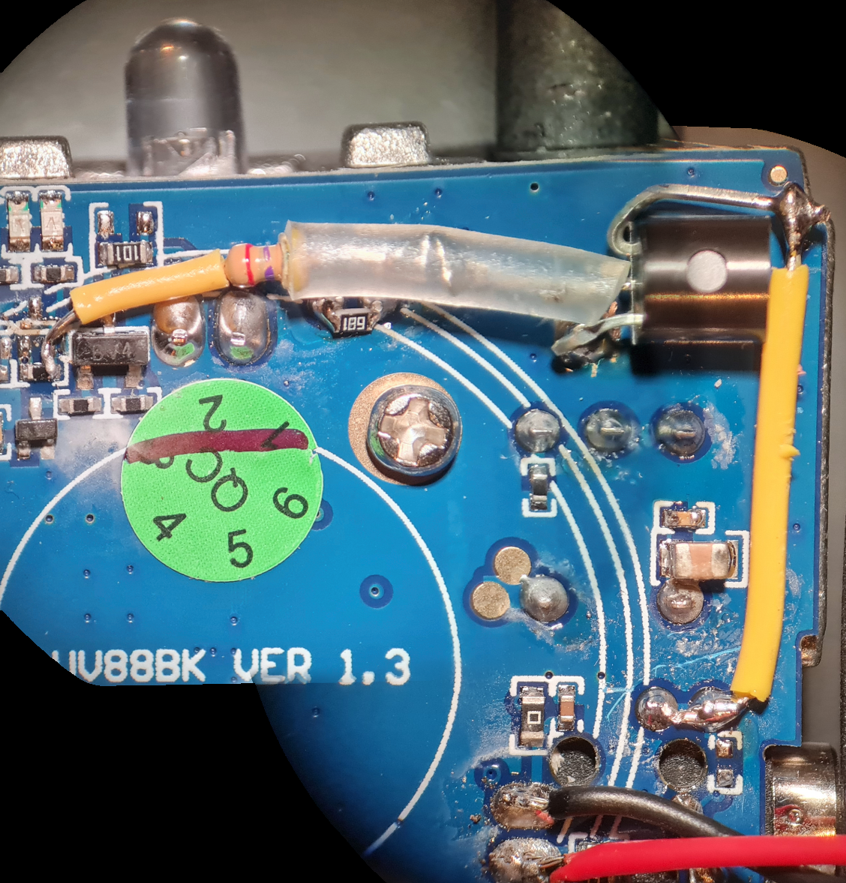This page is linked from How To - Build a High-Quality Full-Duplex AllStar Node for Under $150
It's fairly simple to install a COS line in an RT85 if you have experience in working with surface-mount electronics, and ideally have a microscope (or at least a large magnifying glass) and fine tip soldering iron. The pad to be soldered to is extremely small and requires great care. The wire should be routed and secured prior to being soldered, and ideally no larger than 28 ga. wire used.
The RT85 Green RX LED is tied to Gnd and fed 3.3V through a 330Ω resistor. If using an R1-ASL/202x or other URI that has an active-high COS input, the mod involves simply removing one small resistor and running a wire from the RX LED anode to the 2.5mm jack Ring. If using a URI requiring an active-low COS line, a 2N3904 or other general purpose NPN transistor and 4.7KΩ resistor can be used to provide a standard open-collector COS output. Potentially the simpleusb/usbradio "usb" setting (instead of "usbinvert") could be used, but the RT85's green LED has a 2.5V forward voltage drop, thus a pulldown resistor would be needed for going into an input that expects an open collector output, and at that point it's only 34¢ for a transistor and you then have a standard open-collector COS input that will work with the default ASL config settings.
This mod is optional – the usbradio driver carrierfrom=vox mode works well for detecting even very quiet audio, but hardware COS does ensure 100% reliable carrier detect in all use cases, eg. for those who have a quieter voice or who often pause for a significant time while speaking. COS derived from an RX LED does have one disadvantage which is that signals with no PL tone can cause the LED to light up even if CTCSS decode is enabled, causing keyups with no audio, thus the usbradio vox mode can be better for ensuring only signals with valid PL tone can key up the node. Personally I prefer the higher reliability of hardware COS, and have had no issues with keyups from QRM/QRN with no PL tone. To eliminate any such tradeoffs however a more expensive radio would be needed that has a true COS/SQL output (eg. MiniDIN6 jack) and associated configuration parameters, and in that case no mods would be needed.
The RT85's are easy to open, just take out the 2 screws at the back bottom corners, then remove the nut around the antenna jack (which is easier to do with what's called a "destuffing" tool, made for these types of notched nuts), and the cover then slides off. Be careful to slide it off carefully so as to not pull off the wires going to the built-in speaker.
This mod can be made to an RT85 in well under 15 minutes if you're skilled in surface mount electronics. Otherwise you would be at great risk of damaging the HT, having tiny SMD parts become unsoldered and lost or damaged, and possibly needing to spend $25 on a replacement RT85.
Location of Green RX LED

The first time I modified an RT85 I brought a wire down the left side and made a notch in the case to bring it out, which worked fine but does not look as good because the HT then has an extra wire dangling off the side. So the next time I modified one I brought the line to the HT's 2.5mm Jack instead.
Detail of Retevis RT85 / TYT TH-UV88 2.5mm TRS Speaker Jack

The RT85 has a serial data line on the 2.5mm TRS Jack Ring terminal. Tip is RX Audio, Sleeve is Ground. The data line can be used for programming the radio, but there's no need for that with a node radio that's used on only one frequency and thus doesn't need a bunch of memory channels programmed in. Thus as there is no need for a serial data line on the 2.5mm jack this is the perfect place to route the COS line.
Just to the left of where the speaker jack enters the radio there is an unmarked very small resistor. The PCB has white markings around the top and bottom of it. This is a 100Ω resistor that connects the serial data line to the jack Ring terminal. Remove this resistor.
Mod for Active High COS (eg. for R1 URIs)
Run a short ~30 ga. wire from the resistor that goes to the Green RX LED to the solder point just above the resistor that was just removed. Image below shows a closeup of the area with the RX LED but for active-high COS we need only a single wire between these points rather than a resistor and transistor.
Mod for Active Low COS (eg. for RIM-Lite-V2 URIs)
Solder the transistor emitter to the ground plane of the PCB (which covers most of its area, just scrape off some of the conformal coating). Then connect an 1/8th Watt 4.7KΩ resistor between the transistor Base and the COS attachment point. And finally connect the Collector of the transistor to the 2.5mm Jack terminal solder point just above where the resistor was removed.
Completed Mod Providing Open-Collector Active Low COS Output on 2.5mm TRS Jack Ring

Now carefully reassemble the radio, making sure that no wires or components get wedged in somewhere they shouldn't. The case should close very easily without any significant force needed.
With COS now in place you can use the usbradio or simpleusb driver, and set carrierfrom=usbinvert.